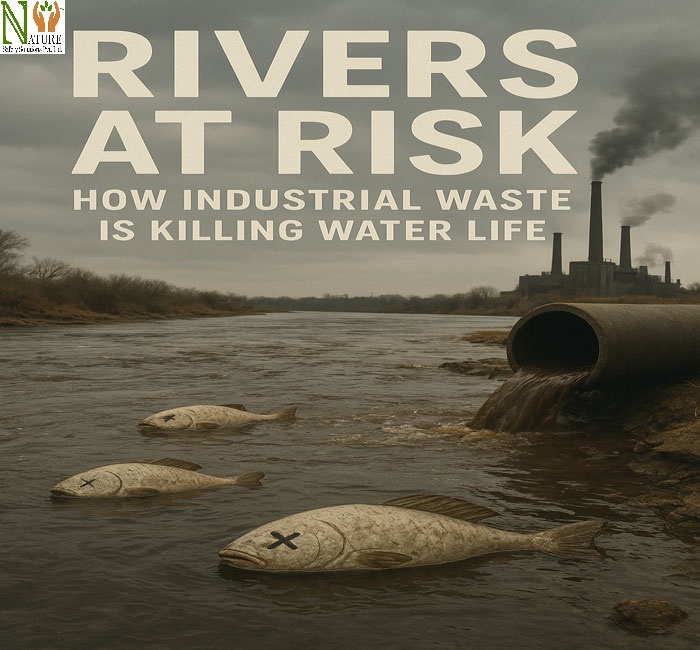Rivers have always been the heartbeat of human life. They quench our thirst, feed our crops, transport goods, and carry spiritual meaning for many cultures. But in recent decades, rivers are suffering a slow death. One of the main reasons is industrial waste.
Factories, in the rush for profit, often discharge untreated chemicals and toxic materials directly into rivers. What once flowed with clean water and vibrant life is now choking under layers of pollution. This destruction threatens not only fish and plants but also the millions of people who depend on rivers daily.

How Industries Pollute Rivers
Every industry – from textile mills to chemical plants – uses water during production. Once used, this water is no longer clean. It carries dyes, acids, oils, plastics, and heavy metals such as mercury and lead. In a healthy system, this wastewater should be treated before being released back into nature.
Sadly, in many places, industries bypass treatment plants to save money. They dump waste directly into rivers, turning them into open sewers. This act may seem convenient for the factories, but it comes at a huge cost: poisoned rivers, dying ecosystems, and unsafe water supplies.
The Silent Death of Aquatic Life
The damage to aquatic life is one of the most tragic effects of industrial pollution.
Fish suffocation: Many chemicals reduce the oxygen levels in water. Without oxygen, fish and other aquatic creatures cannot survive. Large fish kills, where thousands of fish are found floating dead, are now common in polluted rivers.
Poisoned food chains: Heavy metals such as lead and arsenic collect in fish bodies. Birds, animals, and humans that eat these fish also absorb the toxins. This poisoning moves up the food chain, harming many species.
Loss of biodiversity: As pollution worsens, delicate species disappear first. Over time, entire ecosystems collapse, leaving behind lifeless stretches of water.
The river that once supported countless creatures becomes a graveyard of silence.
Impact on Human Communities
Industrial waste in rivers is not just an environmental issue—it is a human one.
Unsafe drinking water: In many developing countries, river water is still used for drinking and cooking. Polluted water brings diseases such as diarrhea, skin infections, and even cancers.
Tainted crops: Farmers who irrigate fields with polluted river water unknowingly allow harmful chemicals to enter vegetables, grains, and fruits. These toxins then reach dinner plates.
Loss of livelihood: Fishing communities suffer greatly when fish die or become unsafe to sell. Their income disappears, and they are forced to find new ways to survive.
The chain of harm is clear: when rivers suffer, people suffer too.
Rivers That Tell the Story
Around the world, several rivers stand as examples of this crisis:
Citarum River in Indonesia: Often called the most polluted river on Earth, it receives tons of untreated waste from textile factories. The water is dark, smelly, and nearly lifeless.
Yamuna River in India: Flowing through Delhi, the Yamuna is heavily polluted by industrial and domestic waste. Once considered sacred, large stretches of the river are now black and foamy.
Mississippi River in the USA: Years of industrial and agricultural pollution have created massive “dead zones” where fish and marine life cannot survive.
Yellow River in China: Known as the “Mother River,” it has suffered greatly due to industrial growth. Pollution has made sections of it unfit for any use.
These rivers tell a shared story: industrial progress without responsibility comes at the cost of clean water and life.
Why the Future Is at Stake
The survival of rivers is directly linked to our future. If industries continue polluting:
- Freshwater sources will shrink.
- More species of fish and aquatic plants will disappear forever.
- Farming will decline because polluted water will harm soils.
- Human health problems will increase, creating heavy medical and economic costs.
Protecting rivers is not an optional task – it is essential for human survival.
The Way Forward
The crisis is serious, but not hopeless. Many solutions exist if governments, industries, and communities work together:
Treatment of waste: All factories must install and operate wastewater treatment plants. Clean water should be returned to rivers, not poison.
Strict laws and monitoring: Strong rules and regular inspections are needed. Industries that pollute must face heavy penalties.
Cleaner production methods: Factories can switch to eco-friendly technologies that use less water and produce less waste.
Community action: Citizens can take part in clean-up drives, raise awareness, and put pressure on industries to act responsibly.
Restoration programs: Replanting riverbanks, reviving wetlands, and restocking fish populations can slowly bring life back to damaged rivers.
Also read:-
